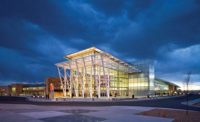 |
| FERCH |
Structural steel boosters have been on the defensive since Sept. 11, 2001, when terrorists destroyed the steel-framed, 110-story towers of Manhattan's World Trade Center. Much effort has gone into propping up steel framing, in reaction to those who purport that the twin tower collapses demonstrated that steel is not a "safe" framing material in fire or under extreme conditions.
With few exceptions, the American Institute of Steel Construction, which is a promotional, technical and standards-writing body, has chosen to respond indirectly to assaults on steel by the misguided and self-serving. The Chicago-based group, which represents fabricators, has focused its energies on issuing information and design guidance on the properties of structural steel under extreme conditions. Work in this area is not new but has been ongoing for four decades, says AISC.
AISC also has started a series of publications called Facts for Steel Buildings. The first, on fire, was issued in October 2003. One on blast and progressive collapse came out last April. The next one will be on seismic design.
Hard copies of all AISC publications can be purchased. But all the material is "downloadable" free to members on aisc.org.
Finding Solutions
Providing free material helps AISC meet its mission of finding and promoting steel solutions, along with getting back to basics such as engineering judgment, says Roger Ferch. Ferch became AISC president in December after 31 years with fabricator Herrick Steel, Pleasanton, Calif.
AISC in 2006 is radically different from AISC in 1996. The organization has broadened its reach beyond fabricators, erectors and steel construction suppliers to serve the entire building team. It also is focused on building type, such as parking garages, in its marketing. An example of the new AISC is a free service, called the Steel Solutions Center, launched in July 2001. The center answers technical questions on myriad subjects, including material specification, vibration, exposed steel, connections and constructibility. The center also helps designers test different steel design solutions. Engineers love it. The center "is an excellent resource to address preliminary design questions, to identify optimal economical framing options or to solve unusual connection issues that arise," says David I. Ruby, president, Ruby & Associates, Farmington Hills, Mich.
"They have been terrific at getting information into the hands of practicing engineers," says James O. Malley, senior principal, Degenkolb Engineers, San Francisco. The "biggest step" forward is that AISC provides professional membership to all engineers in firms "for an unbelievably inexpensive amount, on the order of 10% of the membership cost of other professional organizations," he adds.
AISC is trying to put more teeth into its sometimes-criticized fabricator certification program. And there is always an effort to increase market share of steel buildings, currently at 35%, according to McGraw-Hill Construction Research & Analytics. An underlying goal is to get "the building team working together" in a systematic way, especially through use of technology, says Ferch.


Post a comment to this article
Report Abusive Comment